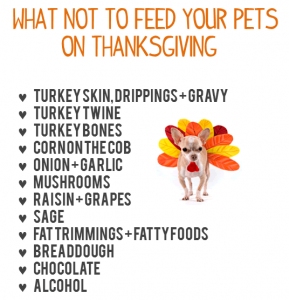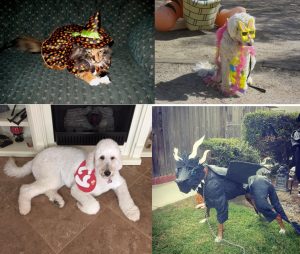Remember only 2 more days to enter our pet Halloween costume drawing. Prize includes new dog bed and other fun pet toys/treats. To enter, like and share our Facebook page, then upload a picture of your pet in a favorite costume. One winner will be picked and notified within the week.
Happy Halloween!!
As Halloween approaches, please keep your pet safe. Please remember some cats, dogs and birds get lost or scared in the hustle and bustle of the night’s activities, seeing scary blow-up decorations, hearing loud and creepy noises and reacting to strobe lights. It is best to keep your pets confined to indoors and away from doors that open and close for kids trick-or-treating on Halloween night. Please remember to keep your pet out of the candy bowl and away from Halloween treats. Packaged raisins, grapes and currants are extremely toxic to dogs and can cause extreme abdominal pain and shut-down of the kidneys. Chocolate and cocoa contain a substance called theobromine, which is similar to caffeine. When consumed in small quantities, is can cause vomiting and diarrhea, and in large quantities, it can cause elevated blood pressure, cardiac arrhythmia, seizures and death. A dog weighing 50#, can be poisoned eating just one ounce of baker’s chocolate or just 9 ounces of milk chocolate. Sugarless candies, gums and peanut butter often contain xylitol, a natural sweetener, which is toxic to dogs. Ingestion of a very small amount can be life-threatening and can cause rapid decrease in blood sugar, can cause seizures and can lead into liver failure. Some essential oils and liquid potpourri, used in some Halloween and other holiday decorations, can be harmful to a pet’s liver or kidneys. A few of these oils include cinnamon, citrus, peppermint, pine, sweet birch, tea tree and wintergreen. Poisoning can happen through ingestion or through contact skin exposure. If you feel your pet may have ingested a toxic substance, please seek immediate veterinary care. A pet poison helpline is also available (fees apply) at 800-213-6680 or visit their website www.petpoisonhelpline.com. For more complete information regarding poisons and tips for care in pets, please visit our website gentleheartsanimalhospital.com and click on the Pet Health Library. From our veterinary family to your family, have a safe and fun Halloween!
HALLOWEEN is coming! Go to our Facebook Page (click on the f icon) to enter our Halloween contest for a chance to win a $70 pet gift basket. Be sure to LIKE and SHARE on the post seen below to enter the contest, then post a picture of your pet in their Halloween costume on our page! Or come into our hospital with your pet in costume and we will upload a picture for you! The contest will run through Halloween. A winner will be announced by November 6th. No purchase necessary!
Gentle Hearts Animal Hospital reserves the right to share or discard any image that is posted.
In the last 2 days, there are local news reports that Canine Influenza has made it to the Phoenix Valley for the first time ever. A new strain of Canine Influenza, strain H3N2, has been identified in a Maricopa County Animal Care facility in two different dogs. This strain originated in birds and mutated over to a virulent form that infects dogs. It was first identified in Chicago in March 2015. It is highly contagious between dogs, and can be transferred through bodily fluids such as saliva or discharge from sneezing. Most dogs will present with similar clinical signs that a person with human influenza might have. These can include a wet cough that may last for days or weeks, vomiting or diarrhea, lethargy, ocular or nasal discharge, sneezing, and/or decreased appetite. Mortality is relatively low and has been reported as 1-5% in dogs that contract canine influenza, and is usually caused from dehydration, secondary infection or because a dog is already compromised from another condition. If you feel your dog has contracted Canine Influenza, it is important to seek veterinary diagnosis and treatment. Dogs can recover from Canine Influenza with appropriate care. Vaccinations and isolation are key factors in limiting this disease. Dogs that are at most risk for contracting Canine Influenza include dogs that frequent areas where there is a high population of dogs (like shows and trials and certain dog parks), dogs in large boarding facilities, dogs that have underlying risk factors including respiratory and cardiac disease, or owners that work with sick or debilitated dogs and then have contact with their own dogs. We carry vaccinations for Canine Influenza. Please call our hospital 623-298-4200 if you would like to set up an appointment for examination. You and our doctor and staff can discuss if this vaccine is appropriate for your dog!
With Summer ending and Fall approaching, we will see a shift in the weather and the wind, and in the death and dormancy of plants, weeds, grasses and insects. Fall is one of the most common seasons we see inhalant allergies in dogs and cats, esp from pollen, mold, dander, dried weeds and grasses, dust and insects. Circulating pollen and dust, inside and outside our homes, can affect our pets. Clinical signs of allergies include biting or scratching more at any part of the body; licking or chewing at tops or bottoms of feet; shaking the head or scratching at ears; discharge, swelling and/or rubbing around the eyes; wheezing or “reverse sneezing”; redness of skin, sores or hair loss; and decreased activity and energy due to scratching all the time. Sometimes our pets will exhibit one or multiple clinical signs. If you feel your pet is having allergies and would like to know how to best treat your pet, please give us a call at 623-298-4200. We can evaluate your pet and decide which treatment course if the best option for you. For more information, look to our website: www.gentleheartsanimalhospital.com/client-resources/pet-health.
What is Valley Fever?
Valley Fever is a disease caused by a fungus, found in the Phoenix area (and other southwest cities and states), known as Coccidiodes immitis. It has two completely different forms, depending on whether it is in the environment or has entered a host animal. When it is in the environment, it exists as a mold. During dry spells, the mold goes dormant in the soil, and can remain dormant for prolonged periods of time. Once the rains come and especially during the monsoon season, the fungus grows and produces long filaments of mold that contain infectious spores. The tiny spores readily become airborne when the soil is disturbed by winds or by construction, farming, or digging. If the spores are inhaled, they transform into a yeast-like organism that infects the lungs. Remember, dogs generally use their noses to sniff the environment and can readily inhale spores in the dust accumulated inside and outside of our homes.
Valley Fever can take two main forms of disease in the dog, the Primary Disease and the Disseminated Disease. The Primary Disease is limited to the lungs. Symptoms of Primary Valley Fever include a harsh dry cough, a fever, a lack of appetite, and/or lethargy or depression. These symptoms usually occur about 3 weeks after infection.
In the Disseminated Disease the fungus has disseminated or spread to other parts of the body. The bones and joints are most commonly infected, and lameness is the most common symptom. The joints may become swollen and painful. Other symptoms are non-specific and may include lack of appetite, lethargy or depression, a persistent fever, and/or weight loss. In rare cases, the fungus invades the brain, resulting in seizure activity or paralysis.
A ‘titer test’ can be used to determine whether your dog has Valley Fever antibodies. Depending on your dog’s symptoms and the severity of illness, your veterinarian may also recommend additional blood tests and diagnostic x-rays of the chest and any affected legs. The fungus can also be detected by microscopic examination of samples of fluids or infected tissue.
What is the treatment for Valley Fever?
At the present time, dogs that develop Valley Fever require lengthy treatment with anti-fungal medications. The duration of treatment will depend on the severity of infection. In many cases, treatment will be required for 6-12 months. And in other cases, if the fungus has specifically invaded the nervous system or is isolated in a specific joint, the dog may require anti-fungal medication for life. Sometimes, additional medication is also needed to help control symptoms, depending on which area of the body is affected.
There are a number of anti-fungal medications for treatment of Valley Fever. Although the treatment is prolonged, the dog usually begins to feel better within 1-2 weeks after the treatment begins.
For more information, please visit https://gentleheartsanimalhospital.com/client-resources/pet-health/articles/?rid=2246 or call us at 623.298.4200 to schedule an appointment.
We wish everyone a Happy Fourth of July. Please be safe and have fun. We will be closed on the fourth to honor the independence date of our country. If you have an emergency, please contact Vetmed Referral and Emergency in Phoenix at 602-697-4694 or Blue Pearl Emergency in Avondale at 623-385-4555. We will open again on Wednesday, July 5th. We thank all the service men and women and their families, past-present-and future, as they continue to keep our country safe.
Some pets can get anxious with all the loud noises and flashes created around July 4th. Please remember to keep your pets indoors and safe as that time approaches. If your pet needs additional help with anxiety during this time, we have some great calming treats and/or pet sedatives to help. Please call our office 623-298-4200 if you would like more information or if you would like to set up an appointment for examination to get medication to help your pet.













